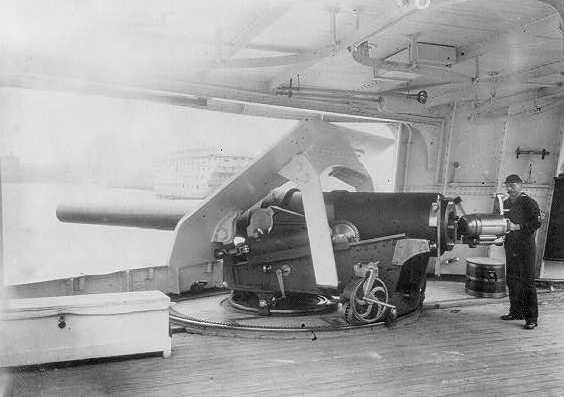
These guns had many similarities in their construction, but, as in most of the "New Navy" gun development, there was much experimentation with different construction techniques, barrel lengths, rifling and ammunition types.
The Mark 1 was the original 6"/30 (15.2 cm) BL gun used on the "ABCD" squadron (Atlanta, Boston, Chicago and Dolphin) with 6" (15.2 cm) gun Serial Number 1 installed on Dolphin. These Mark 1 guns consisted of A tube, jacket, 16 hoops and one elevating band with integral trunnions and a screwed on muzzle bell. The Mark 2 and 3 were also trunnioned guns. Mark 2 Mod 1 had ten hoops, a jacket and a chamber liner while the Mark 2 Mod 2 was the same except having a full-length liner. All Mark 1 and Mark 2 guns were 30 calibers long.
The Mark 3 Mod 0 was also 30 calibers long while the Mark 3 Mod 1 was 35 calibers long. The 30 and 35 caliber mods of the Mark 3 had a tube liner, ten hoops and a jacket. The first 6"/40 (15.2 cm) caliber gun was Mark 3 Mod 2 and was of similar construction to the earlier Mods but with eight hoops. Mark 3 Mod 3 reverted to 30 calibers but introduced case (semi-fixed) ammunition. Mark 3 Mod 4 was an experimental design that eliminated the trunnions in favor of a threaded sleeve arrangement. Mod 5 was a Mod 1 gun reworked to use case ammunition. Mod 6 was a Mod 2 gun reworked to use fixed ammunition. There was no Mod 7 gun and no drawings of this Mod exist. Mod 8 was another Mod 2 gun reworked to use fixed ammunition and had the trunnions removed in favor of using a threaded sleeve. Mod 9 was a Mod 3 gun with a full length liner.
These Mark 1, 2 and 3 guns used a variety of breech mechanisms, primarily variations of the Dasheill and Fletcher types. All Mark 1, 2 and 3 guns were removed from service prior to the start of World War I.
The Mark 4 was an improved design consisting of liner, seven hoops and a jacket. The major change was that this Mark did not have trunnions and was instead designed to be used with a threaded sleeve. Mod 1 had four hoops and had a jacket (hoop) from breech to 61.5 inches (156 cm) from the muzzle and used an experimental Fletcher breech mechanism. The jacket was heavier than that used on the Mod 0. Mod 2 was single gun with a shortened breech. Mod 3 covered four guns with a different sleeve thread. Mod 4 was for a single gun identical to Mod 1 except that it had a raised band near the breech and a different sleeve thread. Mod 5 was identical to Mod 4 but had a muzzle bell. There was no Mod 6. Mod 7 was a Mod 4 gun but with the chamber bored out to take bag ammunition and with tapped side holes to take pressure gauges. This gun was used only for experimental purposes. Mod 8 was a Mod 4 gun with a screwed-on muzzle bell and a muzzle liner. Mod 9 was for three rebuilt Mod 4 guns with a nickel-steel tube and gun-steel locking hoop and a chase hoop. Mod 10 was a Mod 4 lined with a two-step, nickel-steel liner. Mod 11 was three Mod 4 guns with a one-step, nickel-steel liner. Mod 12 was for Mod 4 and 9 guns given a nickel-steel liner. Mod 13 was Mod 5 guns given a nickel-steel liner. Mark 4 Mods 0, 1, 2, 3 and 8 guns were removed from service prior to the start of World War I.
The Mark 7 was a Bethlehem Steel Company design similar to the Mark 4 Mod 5 consisting of liner, three hoops and a jacket. Breech mechanism was a Bethlehem design using an eccentric thread.
The 30 caliber weapons were primarily used on cruisers while the 35 and 40 caliber weapons were used on battleships. As mentioned above, the early Marks were considered to be obsolete by the start of World War I and were all out of service but still in storage by that time. Generally speaking, these guns were designed to use black powder (gunpowder) or brown powder (cocoa) and were not considered to be strong enough to stand up to the higher pressures generated by the new nitrocellulose (SP) propellants then coming into service. The 40 caliber Mark 4 guns were stronger and 45 of them were in active service in June 1917 on warships, armed merchant vessels and in coastal batteries at Guam. An additional 47 guns were in storage at this time giving a total of 92 of these 6" (15.2 cm) guns firing separate ammunition (total probably includes the five Mark 9 guns). Many of these guns were reused during World War I to arm mercantile ships, especially those that were being used as troop transports. One of the Mark 4 guns fired the Navy's first warshot of World War I (see the Additional Pictures section for further information).
Besides the guns with "Mark" number designations, there was a single early wire-wound 6"/30 (15.2 cm) prototype bag gun that was not assigned a Mark number and was used only for experimental purposes. The wire was not covered by a jacket.
| Designation | 6"/30 (15.2 cm) Mark 1 [Bag]
6"/30 (15.2 cm) Mark 2 Mods 1, 2 and 3 [Separate] 6"/30 (15.2 cm) Mark 3 Mod 0 [Bag] 6"/35 (15.2 cm) Mark 3 Mod 1 [Bag] 6"/40 (15.2 cm) Mark 3 Mod 2 [Bag] 6"/40 (15.2 cm) Mark 3 Mod 3 [Fixed] 6"/30 (15.2 cm) Mark 3 Mod 4 [Fixed] 6"/35 (15.2 cm) Mark 3 Mod 5 [Fixed] 6"/40 (15.2 cm) Mark 3 Mod 6 and 8 [Fixed] (there was no Mod 7) 6"/30 (15.2 cm) Mark 3 Mod 9 [Fixed] 6"/40 (15.2 cm) Mark 4 Mods 0 to 13 except Mod 7 [Separate] (there was no Mod 6) 6"/40 (15.2 cm) Mark 4 Mod 7 [Bag] 6"/40 (15.2 cm) Mark 7 [Separate] |
|---|---|
| Ship Class Used On | "New Navy"
6"/30 (15.2 cm): Dolphin, Chicago, Atlanta and Boston Second Class Battleships
Coastal Battleships
Cruisers
Gunboats
|
| Date Of Design | 1883 |
| Date In Service | 1885 |
| Gun Weight | Mark 1: 11,010 lbs. (4,994 kg) without breech
Mark 4: 13,370 lbs. (6,065 kg) without breech Others: N/A |
| Gun Length oa | Mark 1 Mod 0 (30 cal): 189.7 in (4.818 m)
Mark 2 Mod 1 (30 cal): 193.53 in (4.916 m) Mark 3 Mod 0 (30 cal): 196.0 in (4.978 m) Mark 3 Mod 1 (35 cal): 226.0 in (5.740 m) Mark 3 Mod 2 (40 cal): 256.0 in (6.502 m) Mark 3 Mod 3 (30 cal): 196.0 in (4.978 m) Mark 3 Mod 8 (40 cal): 256.25 in (6.509 m) Mark 4 Mod 0 (40 cal): 256.1 in (6.505 m) Mark 4 Mod 1 (40 cal): 254.61 in (6.467 m) |
| Bore Length | 30 Caliber: 180 in (4.572 m)
35 Caliber: 210 in (5.334 m) 40 Caliber: 240 in (6.096 m) |
| Rifling Length | N/A |
| Grooves | N/A |
| Lands | N/A |
| Twist | Mark 1: Increasing RH 1 in 180 to 1 in 30
Mark 2: Increasing RH 1 in 40 to 1 in 30 Mark 3: Increasing RH 0 to 1 in 30 Mark 4 Mod 0: Increasing RH 0 to 1 in 35 Mark 4 other than Mod 0: Increasing RH 0 to 1 in 25 Mark 7: Increasing RH 0 to 1 in 25 |
| Chamber Volume | N/A |
| Rate Of Fire 2 | Bag Guns
As commissioned: 0.66 rounds per minute After about 1906: 7.3 rounds per minute Separate Guns
|
- ^In 1897 the 40 caliber gun (bag ammunition) was timed at one shot every 90 seconds and the 40 caliber RF gun (separate ammunition) at one round every 40 seconds. This was greatly improved by more careful loading practices and better training so that by 1907 the above rates (8.2 seconds and 7.9 seconds, respectively) were achieved.
| Type | Bag and Separate |
|---|---|
| Projectile Types and Weights | AP: 105 lbs. (47.7 kg) |
| Bursting Charge | N/A (usually black powder types with Explosive D being used starting in 1917) |
| Projectile Length | N/A |
| Propellant Charge | 18.8 lbs (8.5 kg) SPD |
| Muzzle Velocity | 30 Caliber: 1,950 fps (594 mps)
35 Caliber: about 2,000 fps (610 mps) 40 Caliber: 2,150 fps (655 mps) |
| Working Pressure | 30 Caliber: 13.3 tons/in2 (2,100 kg/cm2)
Mark 4: 13.7 tons/in2 (2,163 kg/cm2) |
| Approximate Barrel Life | N/A |
| Ammunition Stowage per gun | Texas: 100 rounds
Indiana: 100 rounds Illinois: 200 rounds Cincinnati: 150 rounds Others: N/A |
- The cartridge cases used for the semi-fixed guns were originally supplied with brass cups which sealed the mouth of the cases. During firing practice on S.S. Mongolia in May 1917, one of these cups "boomeranged" back on board where it hit a stanchion and splintered with the splinters killing two nurses and severely wounding a third. During this same time, other ships with these and similar 6" (15.2 cm) semi-fixed guns using cartridge cases were experiencing premature shell detonations, both in and out of the bore. Spurred on by the death of the nurses, the Navy thoroughly investigated the ammunition used for these guns and concluded that the brass cup was damaging the projectile base fuzes and causing the premature shell detonations. Wooden plugs were substituted for the brass cups and these eliminated the problem. As the wooden plugs did not completely seal out moisture, later designs for semi-fixed ammunition cases used a cork plug to seal the case.
| Elevation | Muzzle Velocity | Range |
|---|---|---|
| 15.3 degrees | 1,950 fps (594 mps) | 9,000 yards (8,230 m) |
| 30.2 degrees | 2,150 fps (655 mps) | 18,000 yards (16,460 m) |
| Designation 1b | "New Navy"
Dolphin (1) 2b: Mark 1, Shifting Pivot Atlanta (6), Boston (6) and Chicago (8): Mark 2, Muzzle Pivot Mount Second Class Battleships
Coastal Battleships
Cruisers
Gunboats
|
|---|---|
| Weight | With 6"/30 (15.2 cm): 21,856 lbs. (9,065 kg)
With 6"/40 (15.2 cm): 25,430 lbs. (11,535 kg) |
| Elevation | Mark 3: -7 / +12 degrees for early units, -10 / +12 degrees for later units
Others: N/A |
| Elevation Rate | Manual operation, only |
| Train | about +150 / -150 degrees |
| Train Rate | Manual operation, only |
| Gun recoil | N/A |
- ^Mounting designations shown above for Maine, Texas, Indiana and the cruisers represent my best guess based upon information in the references below and from examination of photographs.
- ^Dolphin was originally armed with one 6"/30 (15.2 cm) gun, but this was quickly removed and she was rearmed with three 4 in (10.2 cm) in 1898 and by 1916 she carried one 4 in (10.2 cm) and two six-pounders.
- ^The Mark 5 was the first rapid fire (RF) recoil mount in the USN.
- During World War I, guns were removed from old battleships in order to arm transports and cargo ships. For example, USS Illinois (B-7) had some of her 6"/40 (15.2 cm) guns removed and given to S.S. Mongolia.


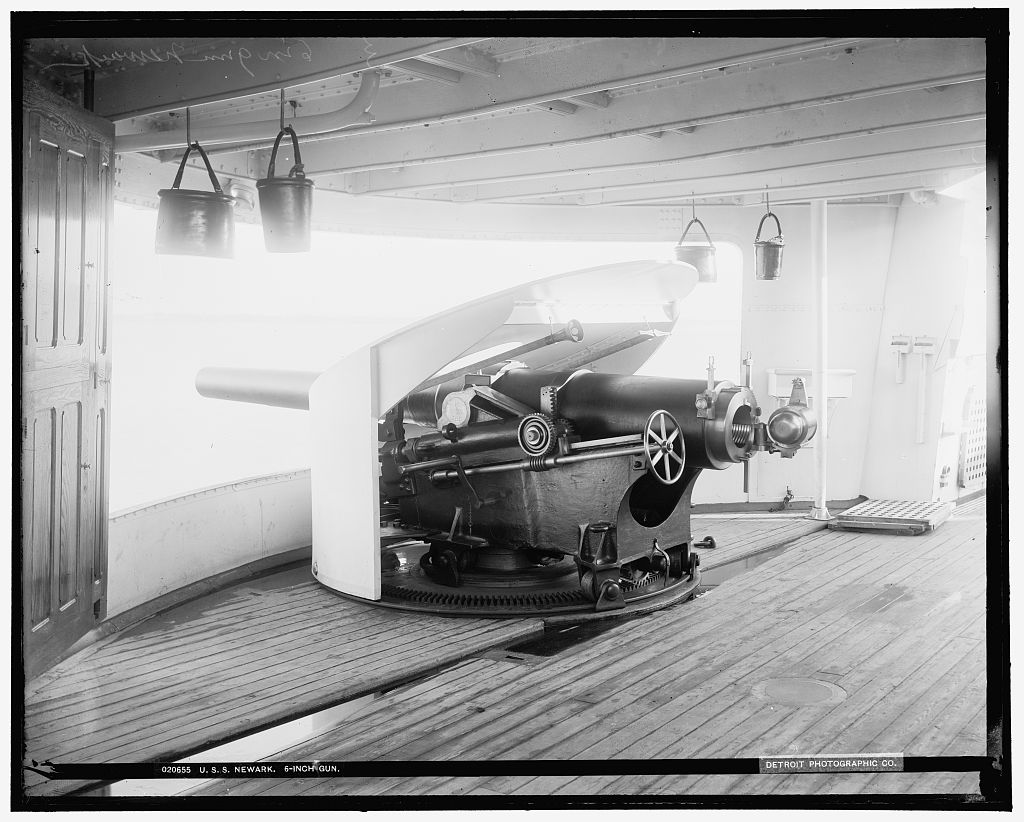


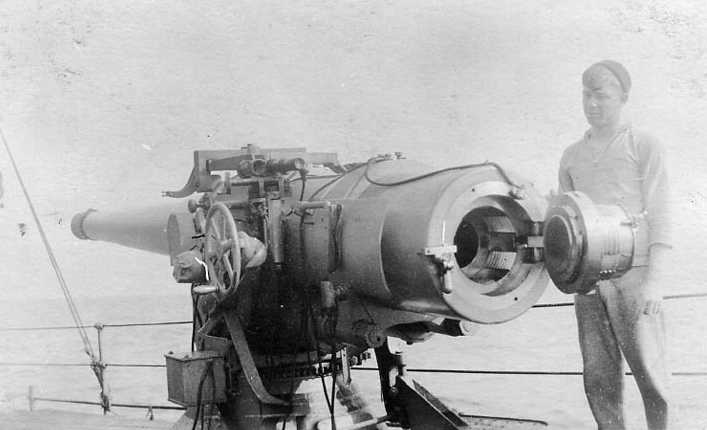
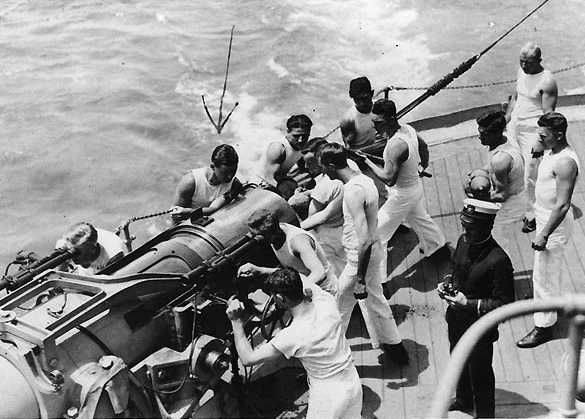
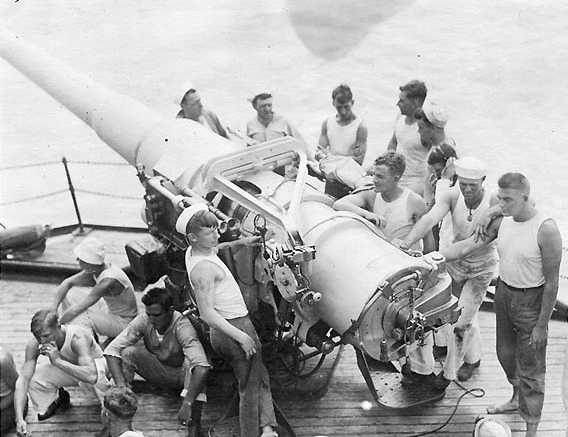
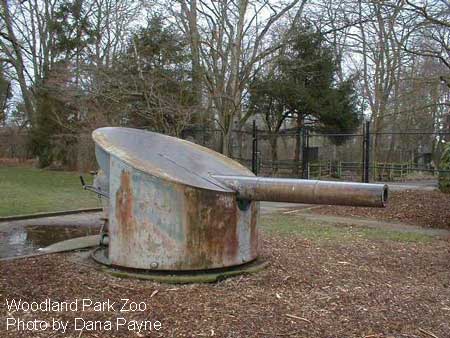
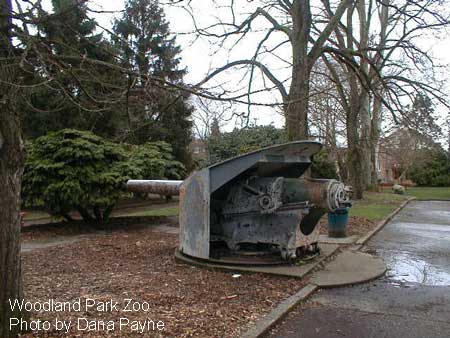
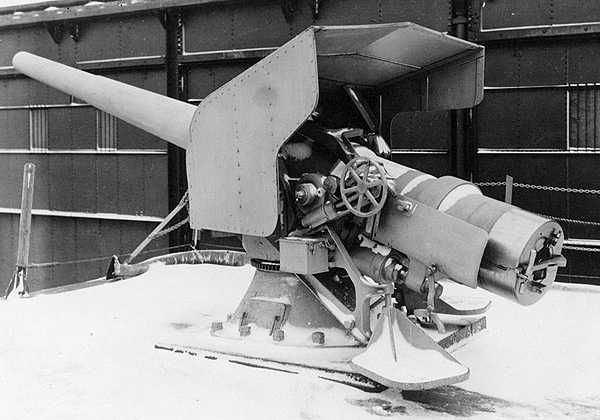
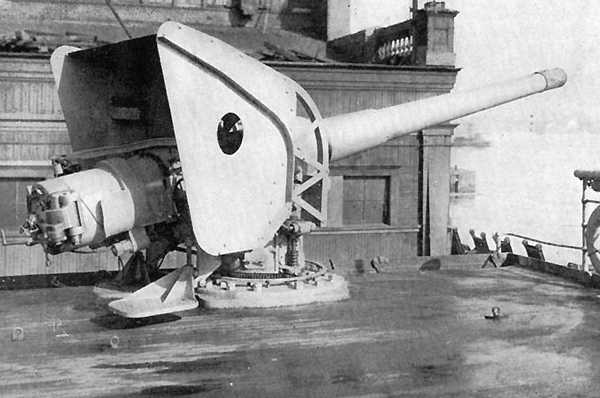

U.S. Navy Armed Guard 6"/40 (15.2 cm) guncrew on S.S. Mongolia in 1917. Officers are identified as Lieutenant Ware and Captain Emory Rice of the U.S. Naval Reserve Force. Note that the shells are painted "TEXAS" and "TEDDY". U.S. Naval Historical Center Photograph # NH 781.
This guncrew fired the first USN warshots of World War I when they engaged the German submarine U.B.40 on 19 April 1917. The action is described on page 439 of "Home Waters Part VIII" as follows:
"U.B.40 then went back to the Owers area, and on April 19, at 5.24 a.m., her periscope was seen in 50° 30' N., 0° 32' W., close to the American S.S. Mongolia (15,638 tons), New York to London, which opened fire with her 6-in. guns at 1,000 yards, and drove her down."
U.B.40 appears to have suffered little if any damage during this action and survived until 5 October 1918 when she was scuttled off Ostende during the German retreat from Belgium. S.S. Mongolia was officially taken over by the Navy in April 1918 and then commissioned as USS Mongolia ID-1615.
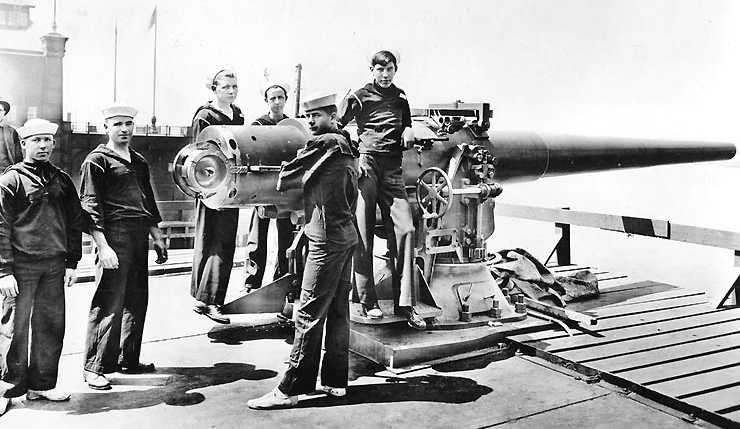
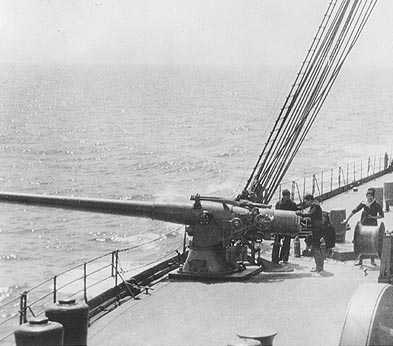
"US Battleships: An Illustrated Design History," "US Cruisers: An Illustrated Design History" and "US Naval Weapons" all by Norman Friedman
---
"United States Naval Guns: Their Marks and Modifications" Ordnance Pamphlet No. 127, December 1916, Revised January 1918
"United States Naval Guns: Their Marks and Modifications" Ordnance Pamphlet No. 127, December 1916, Second Revision June 1924
---
"Casualties Aboard Steamship Mongolia" - Hearings before the United States Senate Committee on Naval Affairs in June 1917
Gene Slover's Navy Pages
25 December 2008 - Benchmark
11 May 2009 - Added photograph of USS Powatan
03 May 2015 - Added photographs of S.S. Mongolia, additional information regarding construction of various Marks and Mods. Added note regarding problems with cartridge case brass cups.
22 June 2020 - Converted to HTML 5 format, added information on guns on S.S. Mongolia
